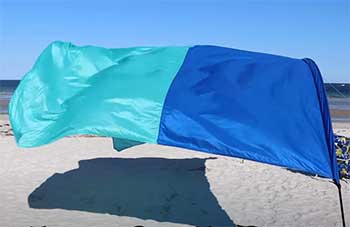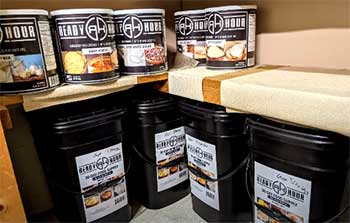Choosing the perfect beach shade can be a game-changer for your sunny outings. Recently, I was caught between two popular options: Neso and Shibumi shades. Both promise to deliver optimal shade and comfort, but they have unique features that set them apart.
In this article, I’ll share my personal experience with both, diving into the pros and cons to help you decide which one suits your needs better. Whether you’re looking for ease of setup, durability, or affordability, this comparison will guide you to make an informed decision.
Let’s get started!
A Brief Comparison Table
| Feature | Neso Shades | Shibumi Shades |
| Ease of Setup | Simple but requires anchoring with sand | Extremely easy, relies on wind |
| Portability | Lightweight, compact | Very lightweight, packs into a small bag |
| Durability | High-quality materials, sturdy | Durable fabric, wind-dependent |
| Shade Coverage | Moderate to large depending on size | Large, but can be less stable in low wind |
| Price Range | $85 – $125 | $250 |
| Aesthetics | Various colors and patterns | Unique design, typically blue and green |
| Environmental Impact | Minimal plastic use, eco-friendly | Eco-friendly, minimal plastic use |
| Wind Resistance | Good, requires anchoring | Excellent in strong winds, less effective in calm conditions |
| UV Protection | UPF 50+ | UPF 30+ |
In-depth Differences Between Neso And Shibumi Shades

- Ease of Setup
When it comes to setting up a beach shade, ease and convenience are key. No one wants to wrestle with a complicated tent while the sun beats down.
Setting up a Neso shade is relatively straightforward. You start by laying out the canopy, filling the anchor bags with sand or rocks, and then adjusting the aluminum poles to lift the canopy. It can take a bit of practice to get the tension just right, but once you do, it’s a reliable setup.
Shibumi shades, on the other hand, pride themselves on simplicity. The setup involves threading a single, flexible rod through the canopy and letting the wind do the rest.
This can be a huge advantage, especially if you’re dealing with children or just want to relax quickly. However, the reliance on wind can be a downside on particularly calm days.
- Portability
When you’re trekking to the beach, the last thing you want is to lug around heavy gear. Both Neso and Shibumi shades score high marks for portability.
Neso shades are lightweight and come with a convenient carrying bag. They pack down small, making them easy to toss into your car or even a backpack.
Shibumi shades take portability to the next level. Weighing in at just a few pounds and packing into a small, easy-to-carry bag, they’re incredibly convenient for travel.
- Durability
Beach gear needs to withstand sun, sand, and wind. Durability is a crucial factor in choosing the right shade.
Neso shades are built to last. The canopy is made from a high-quality nylon/lycra blend that’s both stretchy and tough. The aluminum poles are lightweight yet sturdy, designed to resist rust and corrosion.
Shibumi shades are made from a durable, water-resistant fabric that holds up well under windy conditions. The flexible rod is designed to bend without breaking, providing a reliable structure that can endure strong gusts.
- Shade Coverage

The main purpose of a beach shade is to provide, well, shade. Let’s compare how each option performs in this department.
Neso shades come in various sizes, offering a range of coverage options. Whether you need shade for two people or a larger group, there’s a Neso size to match your needs. The design allows for adjustable angles to maximize shade throughout the day.
Shibumi shades offer extensive coverage, but their effectiveness can depend on the wind. On a windy day, they provide ample shade, covering up to six people comfortably. However, on calmer days, the shade may not be as effective.
- Price Range
Price is always a consideration when making a purchase. Here’s a quick look at the cost of each shade.
Neso shades are generally more affordable, ranging from $85 to $125 depending on the size and model. This makes them a budget-friendly option without compromising on quality.
Shibumi shades come with a higher price tag, typically around $250. While they offer unique features and excellent wind performance, the cost might be a factor for budget-conscious buyers.
- Aesthetics
Let’s face it, we all want our beach setup to look good. Both Neso and Shibumi offer appealing designs.
Neso shades come in a variety of colors and patterns, allowing you to choose a style that suits your taste. Whether you prefer bold colors or more subdued tones, there’s a Neso design for you.
Shibumi shades are known for their distinctive blue and green color scheme. The design is eye-catching and stands out on the beach, but it’s less customizable compared to Neso.
- Environmental Impact
Being eco-friendly is an increasingly important factor for many of us. Here’s how Neso and Shibumi stack up.
Neso shades are designed with minimal plastic use and eco-friendly materials. The company emphasizes sustainability, which is a big plus in my book.
Shibumi shades also focus on sustainability, using minimal plastic in their design. Their lightweight, durable fabric is made to last, reducing the need for frequent replacements.
- Wind Resistance

Beach shades need to withstand windy conditions without collapsing.
Here’s how each brand performs.
Neso shades have good wind resistance when properly anchored.
The key is to ensure the sandbags are filled and the canopy is taut. Once set up, they can handle moderate to strong winds.
Shibumi shades excel in windy conditions. The design actually relies on the wind to stay up, making them extremely stable in breezy weather. However, on days with little to no wind, they can be less effective.
- UV Protection
Protecting your skin from harmful UV rays is crucial. Let’s compare the UV protection offered by Neso and Shibumi shades.
Neso shades provide UPF 50+ protection, blocking out harmful UV rays and keeping you safe under the sun.
Shibumi shades offer UPF 30+ protection. While still effective, it’s slightly less than what Neso provides.
Frequently Asked Questions (FAQ)
Absolutely, Neso tents are worth it if you’re looking for a reliable, affordable, and portable beach shade. They provide excellent UV protection and come in various sizes to accommodate different needs. The setup might take a bit of practice, but once you get the hang of it, they’re a fantastic option for beachgoers.
As of now, Shibumi shades are banned in some beaches due to their design, which can be seen as obtrusive or potentially hazardous in crowded areas. It’s always best to check local beach regulations before bringing your Shibumi shade.
Yes, the Shibumi Shade is worth it if you value ease of setup and performance in windy conditions. It’s more expensive than other options, but its unique design and high wind resistance can justify the price for many users.
Currently, Shibumi shades are not allowed at Hilton Head beaches. The local regulations have specific guidelines for beach equipment to ensure safety and accessibility, and Shibumi shades do not meet these criteria. Always check the latest beach rules before planning your visit.
Wrapping Up
After weighing the pros and cons, it’s clear that both Neso and Shibumi shades have their strengths. If you prioritize affordability, UV protection, and a variety of designs, Neso might be the right choice for you.
On the other hand, if ease of setup and wind performance are your top concerns, Shibumi could be the way to go. Personally, I found myself leaning towards Neso for its versatility and price point, but you might find Shibumi’s innovative design more appealing.
In the end, it comes down to your specific needs and preferences. Either way, you’re investing in a product that will make your beach days more enjoyable. So, grab your shade, hit the beach, and soak in the sun—without the burn!

